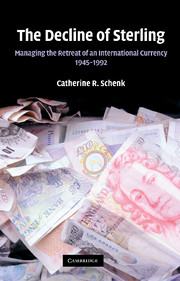Part II - Accelerating the Retreat: Sterling in the 1960s
Published online by Cambridge University Press: 04 May 2010
Summary
The reduction of sterling's international role as a reserve currency was an underlying feature of British policy throughout the 1960s, although no effective way was found to achieve this until the Sterling Agreements of 1968. The crumbling of the pegged exchange rate system, multilateral efforts to replace or reform it and the reorientation of Britain's external focus from empire to Europe and the United States all underlay the development of sterling policy. The great turning point seemed to be the dramatic devaluation of sterling in 1967, but in the end it was EEC membership that prompted the public acknowledgement that the reserve role of sterling would be actively reduced as a matter of official policy. Internally there is clear evidence that voices at the highest level of the Treasury and the Bank of England had come to this view at the beginning of the decade, but there seemed little scope to achieve this in the pegged exchange rate regime. Successive British governments pursued a strategy of gathering multilateral support to reduce the risk of a sudden diversification of global reserves away from sterling, which allowed a fairly smooth reduction in sterling's share of global reserves to a mere 7 per cent by 1970.
As an international commercial currency, sterling's relative position also declined. This process was most closely related to the United Kingdom's relative decline in world trade, but it was also a by-product of continued and intensified exchange controls on the international commercial use of sterling during the 1950s and 1960s.
- Type
- Chapter
- Information
- The Decline of SterlingManaging the Retreat of an International Currency, 1945–1992, pp. 117 - 118Publisher: Cambridge University PressPrint publication year: 2010



